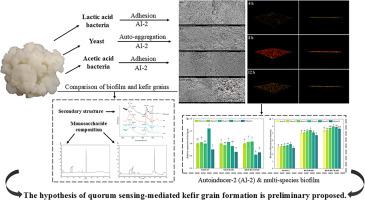Quorum sensing mediated kefir grain extracellular matrix formation hypothesis based on biofilm
IF 6.8
1区 农林科学
Q1 FOOD SCIENCE & TECHNOLOGY
Innovative Food Science & Emerging Technologies
Pub Date : 2025-08-19
DOI:10.1016/j.ifset.2025.104181
引用次数: 0
Abstract
Kefir possesses numerous health benefits, but its starter kefir grains propagate slowly and can only be cultured from existing grains. To support the optimization of kefir fermentation and the development of functional foods, this study investigated the formation of kefir grain extracellular matrix. Focusing of biofilms and quorum sensing, we explored biofilm formation by dominant strains (one strain of Lentilactobacillus kefiri, one strain of Kluyveromyces marxianus and one strain of Acetobacter fabarum with strong biofilm formation capabilities) isolated from kefir to elucidate the mechanism of extracellular matrix formation. The monosaccharide composition and secondary structures of biofilms and kefir grain extracellular matrix were compared. Additionally, this study analyzed the relationship between biofilm formation by mixed culture of three dominant strains and autoinducer-2 activity and examined biofilms at different time points using scanning electron microscopy and co-aggregation microscopy. The results revealed that the biofilms formed by the mixed strains closely resembled the structure and composition of the kefir grain extracellular matrix and was mediated by quorum sensing. L. kefiri and A. fabarum were observed to encapsulate K. marxianus to form biofilms. This study is the first to provide an understanding of the quorum sensing-mediated formation of the kefir grain extracellular matrix, providing a foundation for transitioning from traditional kefir grain fermentation to design synthetic kefir grains.

基于生物膜的群体感应介导开菲尔颗粒胞外基质形成假说
开菲尔具有许多健康益处,但它的发酵剂开菲尔颗粒繁殖缓慢,只能从现有的颗粒培养。为优化克非尔发酵工艺和开发功能食品,本研究对克非尔颗粒细胞外基质的形成进行了研究。以生物膜和群体感应为重点,研究了从开菲尔菌中分离的优势菌株(1株克氏慢乳杆菌、1株马氏克鲁维菌和1株具有较强生物膜形成能力的fabarum醋酸杆菌)的生物膜形成机制,以阐明细胞外基质的形成机制。比较了生物膜和开菲尔颗粒细胞外基质的单糖组成和二级结构。此外,本研究还分析了三种优势菌株混合培养形成生物膜与自诱导剂-2活性的关系,并利用扫描电镜和共聚集显微镜对不同时间点的生物膜进行了检测。结果表明,混合菌株形成的生物膜与开菲尔颗粒胞外基质的结构和组成非常相似,并通过群体感应介导。观察到L. kefiri和A. fabarum包封K. marxianus形成生物膜。本研究首次了解了群体感应介导的开非尔颗粒胞外基质的形成,为从传统的开非尔颗粒发酵过渡到设计合成开非尔颗粒提供了基础。
本文章由计算机程序翻译,如有差异,请以英文原文为准。
求助全文
约1分钟内获得全文
求助全文
来源期刊
CiteScore
12.00
自引率
6.10%
发文量
259
审稿时长
25 days
期刊介绍:
Innovative Food Science and Emerging Technologies (IFSET) aims to provide the highest quality original contributions and few, mainly upon invitation, reviews on and highly innovative developments in food science and emerging food process technologies. The significance of the results either for the science community or for industrial R&D groups must be specified. Papers submitted must be of highest scientific quality and only those advancing current scientific knowledge and understanding or with technical relevance will be considered.

 求助内容:
求助内容: 应助结果提醒方式:
应助结果提醒方式:


